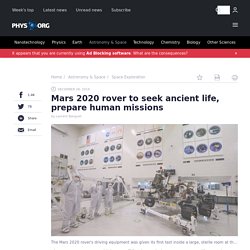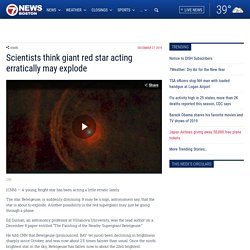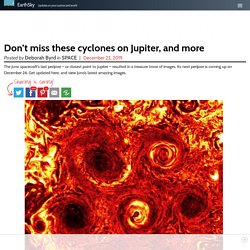

U.S. astronaut sets record for longest spaceflight by a woman. A U.S. astronaut set a record Saturday for the longest single spaceflight by a woman, breaking the old mark of 288 days with about two months left in her mission.

Christina Koch, a 40-year-old electrical engineer from Livingston, Mont., arrived at the International Space Station on March 14. She broke the record set by former space station commander Peggy Whitson in 2016-2017. Koch is expected to spend a total of 328 days, or nearly 11 months, on board the space station before returning to Earth.
Missions are typically six months, but NASA announced in April that it was extending her mission until February. The U.S. record for longest spaceflight is 340 days set by Scott Kelly in 2015-2016. Koch’s extended mission will help NASA learn about the effects of long spaceflights, data that NASA officials have said is needed to support future deep space exploration missions to the moon and Mars. Six Eclipses, Three Supermoons and A Rare ‘Great Solstice Appulse’: A Skywatcher’s Guide To 2020. Mars 2020 rover to seek ancient life, prepare human missions. The Mars 2020 rover, which sets off for the Red Planet next year, will not only search for traces of ancient life, but pave the way for future human missions, NASA scientists said Friday as they unveiled the vehicle.

The rover has been constructed in a large, sterile room at the Jet Propulsion Laboratory in Pasadena, near Los Angeles, where its driving equipment was given its first successful test last week. Shown to invited journalists on Friday, it is scheduled to leave Earth in July 2020 from Florida's Cape Canaveral, becoming the fifth US rover to land on Mars seven months later in February. "It's designed to seek the signs of life, so we're carrying a number of different instruments that will help us understand the geological and chemical context on the surface of Mars," deputy mission leader Matt Wallace told AFP. Among the devices on board the rover are 23 cameras, two "ears" that will allow it to listen to Martian winds, and lasers used for chemical analysis. Scientists think giant red star acting erratically may explode. (CNN) — A young, bright star has been acting a little erratic lately.

The star, Betelgeuse, is suddenly dimming. It may be a sign, astronomers say, that the star is about to explode. Another possibility is the red supergiant may just be going through a phase. Galactic cosmic ray model works without physics, and that is bad. Way back when the world was young and I still attended physics conferences, I got very excited by galactic cosmic rays.

There seemed to be more cosmic rays than expected coming from the center of our galaxy. Those excess cosmic rays might be evidence for dark matter, which would be a big breakthrough if confirmed. Later modeling of cosmic ray sources showed that the extra cosmic rays were probably not coming from the annihilation of dark matter. But, now it seems we are back to square one, because that model may not have been accurate. Www.cosmos.esa. Gaia: Mapping a Billion Stars. Gaia is a European Space Agency space telescope that maps the positions of more than 1 billion stars to the highest precision yet of any mission.

Its extended mission is expected to last until at least December 2020, and Gaia has already generated several data releases of information since its mission began in 2013. The latest data release in April 2018 plotted the positions of more than 1.7 billion stars, which was released in a 3D color map at the ILA Berlin Air Show. The data not only plots the positions of stars, but also helps astronomers understand stellar evolution and history. [Photos: Gaia Spacecraft to Map Milky Way Galaxy] Development, operations and science goals. Betelgeuse is 'fainting' but (probably) not about to explode. Betelgeuse imaged in ultraviolet light by the Hubble Space Telescope, and subsequently enhanced by NASA.

The bright white spot is likely one of this star’s poles. Image via Andrea Dupree/ Ronald Gilliland/ NASA/ ESA/ Britannica.com. The red supergiant star Betelgeuse – in the shoulder of the constellation Orion the Hunter – is one of the easiest-to-recognize stars in the night sky. It’s also one of the biggest stars we know, with a radius extending out to the distance of Mars’ from our sun, and possibly Jupiter! New rules illuminate how objects absorb and emit light. Princeton researchers have uncovered new rules governing how objects absorb and emit light, fine-tuning scientists' control over light and boosting research into next-generation solar and optical devices.

The discovery solves a longstanding problem of scale, where light's behavior when interacting with tiny objects violates well-established physical constraints observed at larger scales. An approach for constructing non-Hermitian topological invariants in real space. In physics, non-Hermitian systems are systems that cannot be described by standard (i.e., Hermitian) laws of quantum mechanics, or more precisely, that can only be described by non-Hermitian Hamiltonians.

Non-Hermitian systems are ubiquitous in nature. Many open systems, i.e., systems that are not fully isolated from the rest of the world, belong to this class. The topology of these systems (i.e., robust properties that are immune to any changes of parameters) is fundamentally shaped by the so-called "non-Hermitian skin effect," which leads to unconventional bulk-boundary correspondence, which has never been observed in Hermitian systems. Under a DAPPER Moon: NASA Eyes Wild Radio Science Projects on the Lunar Farside. NASA's quest to return humans to the moon could boost a field of research that might not seem particularly lunar in nature: cosmology.

But the far side of the moon could be a powerful place to answer some of the most compelling questions about the universe — and NASA's push to bring humans back to the moon could cut the prices enough to make this science a reality. Even a scientist leading the push for NASA to investigate these missions admits it wasn't the most intuitive idea when he first heard about it. "We were [science fair] judges together and they were asking me what I thought about telescopes on the moon," Jack Burns, an astrophysicist at the University of Colorado Boulder, told Space.com. "And I said, I didn't think much about it at all. It just didn't occur to me. " Don't miss these cyclones on Jupiter, and more. Jupiter’s south pole as seen from the Juno spacecraft on November 4, 2019.

These swirling spots are cyclones at Jupiter’s pole. The whole hexagonal arrangement of cyclones is large enough to dwarf the Earth. The central cyclone can be compared to the continental U.S. Astronomers Have Found an Earth-Size Planet Practically Next-Door to Us. Our neighbourhood in space is turning out to be quite the populous planet precinct. Astronomers have found a new exoplanet just a little bit bigger than Earth, orbiting a red dwarf star just 66.5 light-years away. It's an excellent candidate, they say, to help fill our vast knowledge gap about the small, rocky planet population of our Milky Way galaxy. Our detection ability and knowledge of exoplanets has practically exploded since the first discovery was published in 1992.
A Journey Into the Milky Way Galaxy Documentary - The Most Interesting Galaxy in the Universe. Farthest Known Galaxy in the Universe Discovered Journey into the Center of the Universe Documentary. NASA, Boeing investigating why Starliner spacecraft missed orbit. REUTERS: The Boeing Co Starliner spacecraft that failed to hit the right orbit to reach the International Space Station is healthy, in a stable orbit and expected to land in New Mexico on Sunday morning, NASA said.
Boeing's CST-100 Starliner astronaut capsule was successfully launched from Florida on Friday, but an automated timer error prevented the spacecraft from attaining the correct orbit for it to rendezvous and dock with the space station. NASA and Boeing officials said on a Saturday conference call they are still investigating the cause of the failure and that they were surprised extensive testing before the flight did not turn up any problem. The spacecraft's challenges were not over, they said. "Entry, descent and landing is not for the faint of heart," said Jim Chilton, senior vice president of Boeing's space division. NASA Hails Historic Landing by Boeing's Starliner Capsule, But Next Steps Still Murky. Today is a very big day for human spaceflight, NASA officials said, but it's still unclear what tomorrow will bring. Boeing's CST-100 Starliner capsule landed safely at White Sands Missile Range in New Mexico this morning (Dec. 22), bringing an end to its truncated debut mission, the uncrewed Orbital Flight Test (OFT).
Asteroid collisions trigger cascading formation of subfamilies, study concludes. Billions of years ago, asteroid collisions resulted in the ejection of fragments hundreds of kilometers across and sharing similar orbits. The resulting groups are known as asteroid families. Other asteroid groups formed as a result of rotational fission, which happens when a rapidly spinning body reaches critical rotation speed and splits into relatively small fragments only a few kilometers across. Scientists have always thought about fission clusters as entirely distinct from collisional families. Galaxy gathering brings warmth. No Dark Energy? No Chance, Cosmologists Contend. Dark energy, mysterious as it sounds, has become part of the furniture in cosmology. Giant Gas 'Halos' Fed Hungry Black Holes at the Dawn of the Universe.
Gas halos surround some of the earliest galaxies in the universe, providing a reservoir of cool gas that fuels the growth of supermassive black holes. Using the European Southern Observatory's (ESO) Very Large Telescope (VLT), astronomers observed these gas halos around galaxies that formed more than 12.5 billion years ago. No, Scientists Will Never Be Able To Remove The Empty Space From Atoms.
How Boeing's Starliner Orbital Flight Test Works. What Is The Ultimate Fate Of The Loneliest Galaxy In The Universe? ESA/Hubble & NASA and N. Gorin (STScI); Acknowledgement: Judy Schmidt. 100 red objects in deep space vanished over the past 70 years. A group of scientists says giant alien-built structures could be to blame. One hundred red objects in deep space seem to have mysteriously vanished over the past 70 years.Researchers say the objects could be lasers that aliens use to communicate across interstellar space, or stars that aliens covered with megastructures.The objects could also be the first evidence of "failed supernovae": stars that collapsed directly into black holes, without any supernova explosion.Visit Business Insider's homepage for more stories.
Boeing's Starliner Won't Reach Space Station After Launch Anomaly, NASA Chief Says. CAPE CANAVERAL, Fla. — Boeing's Starliner astronaut taxi suffered an anomaly today (Dec. 20) during its flight to the International Space Station during the Orbital Flight Test (OFT) mission. Scientists find iron 'snow' in Earth's core. The Earth's inner core is hot, under immense pressure and snow-capped, according to new research that could help scientists better understand forces that affect the entire planet.
Scientists find iron 'snow' in Earth's core. What Is The Ultimate Fate Of The Loneliest Galaxy In The Universe? 100,000 Supernovas Erupted in the Milky Way a Billion Years Ago. Supermassive Black Hole in the Milky Way Documentary - Black Holes and Energy Scales of the Universe. The 'cores' of massive galaxies had already formed 1.5 billion years after the Big Bang. NASA has confirmed a new class of huge 'super-puff' planets that have the density of cotton candy. 2019 December 20 - Late Afternoon on Mars. Arianespace Soyuz Successfully Launches ESA's CHEOPS Exoplanetary Mission - SpaceWatch.Global. Giant Gas 'Halos' Fed Hungry Black Holes at the Dawn of the Universe.
A Stellar Mystery: How Could 100 Stars Just Vanish? GOCE Gravity Mapper Reveals What’s Going on Deep Below Antarctica. Scientists find iron 'snow' in Earth's core. Methane Mystery on Mars May Get a Partial Answer Soon. Supermassive Black Hole in the Milky Way Documentary - Black Holes and Energy Scales of the Universe. Boeing's Starliner Atlas V Rocket Ride Is Wearing a 'Skirt' for Launch. Here's Why. Engadget is now a part of Verizon Media. Methane Mystery on Mars May Get a Partial Answer Soon. NASA GISMO Reveals 1,000 Trillion Mile Long Cosmic ‘Candy Cane’ in Milky Way. Starliner test flight to use special Atlas 5 configuration, unusual launch trajectory. ESO observations reveal black holes' breakfast at the cosmic dawn. Earth's Magnetic North Pole Keeps Moving Towards Siberia at a Mysteriously Fast Pace. 2019 December 18 - A Hotspot Map of Neutron Star J0030s Surface.
How to Watch Boeing's 1st Starliner Test Flight to the Space Station Online. Europe’s space agency just launched a satellite to study planets outside our solar system. Artificial intelligence may help scientists make spray-on solar cells. How to use entanglement for long-distance or free-space quantum communication. SpaceX to cap transitional year with launch, poised for big things in 2020.
How does our Milky Way galaxy get its spiral form? First Map of a Pulsar's Surface Reveals 'Hotspots' in Unexpected Places. Astrophysicists Discover a Neutron Star With a Bizarre Magnetic Field. Moon FARSIDE: Proposal for Dark Ages and Exoplanet Investigations. A second black hole at our galaxy's center? Spacecraft spots asteroid debris responsible for spectacular meteor shower. Astronomers map a neutron star’s surface for the first time.
OSIRIS-REx spacecraft spots particles ejected from asteroid and selects landing spot. 100 mysterious blinking lights in the night sky could be evidence of alien life... or something weird, say boffins. Middle of eclipse season December 30, 2019. Newfound Martian aurora actually the most common; sheds light on Mars' changing climate. Astronomers Find Black Holes Stirring Up the Biggest Galaxies. Astronomers find 19 more galaxies missing their dark matter. Spacecraft spots asteroid debris responsible for spectacular meteor shower. How to See the 2019 Geminid Meteor Shower Peak Tonight, Despite Bright Moon. Astronomers map a neutron star’s surface for the first time. How an Icy Moon of Saturn Got Its Stripes. Full Moon In Gemini December 2019: Astrology Meaning. Our Large, Adult Galaxy Is As Massive As 890 Billion Suns. The return to Venus and what it means for Earth.
Impossibly Big Black Hole Was Probably Impossible After All. How A.I. Could Help Find Alien Planets and Asteroids. How Spiral Galaxies Get Their Shape. Our Only Known ‘Asteroid Shower’ Peaks This Weekend Under A Near-Full Moon. Here’s How To Watch. Denman Glacier: Deepest point on land found in Antarctica. ALMA spots most distant dusty galaxy hidden in plain sight. MIT Physicists Believe There’s Dark Matter at the Center of the Milky Way. Water is ‘common’ on alien worlds, scientists say in finding that could transform search for extraterrestrial life. This was the decade the commercial spaceflight industry leapt forward. Heat energy leaps through empty space, thanks to quantum weirdness. Weird Physics of 'Tiger Stripes' on Icy Saturn Moon Enceladus Finally Explained. Our Only Known ‘Asteroid Shower’ Peaks This Weekend Under A Near-Full Moon. Here’s How To Watch.
ISS Sees Thunderstorm Beaming Electromagnetic Pulse Into Space, Producing Gamma Rays and 'Elves' Neutron Flashes Never-Before-Seen Type of Magnetic Field at Earth. When And Where To Watch A Rare ‘Cold Moon Kiss’ This Week As Venus And Saturn Appear Super-Close. ‘We Are Going To Get It Done’ - SpaceX Says It Is Trying To Stop Its Starlink Satellites Ruining The Night Sky. Impossibly Big Black Hole Was Probably Impossible After All. This Is How Astronomers Know The Age Of The Universe (And You Can, Too) When And Where To Watch A Rare ‘Cold Moon Kiss’ This Week As Venus And Saturn Appear Super-Close. Further Evidence Discovered for Dwarf Galaxies That Are Inexplicably Deficient in Dark Matter. The Interstellar Comet Has Arrived in Time for the Holidays.
In surprise breakthrough, scientists create quantum states in everyday electronics. Decade's final full moon on Dec. 12 at 12:12 a.m. What Makes This Low-Mass White Dwarf So 'Impossible' to Behold? Swiss startup ClearSpace wins ESA contract to deorbit Vega rocket debris. How planets may form after dust sticks together.